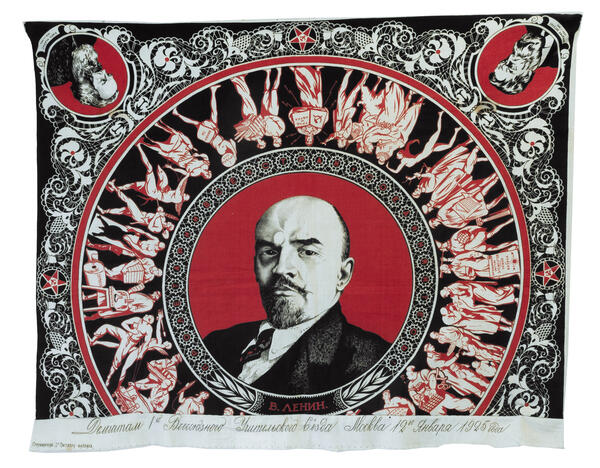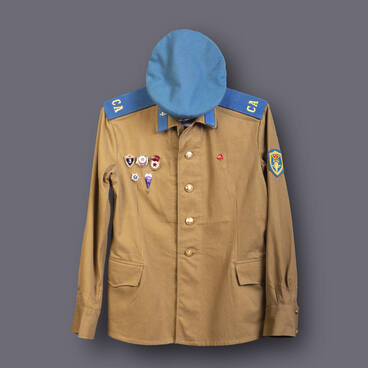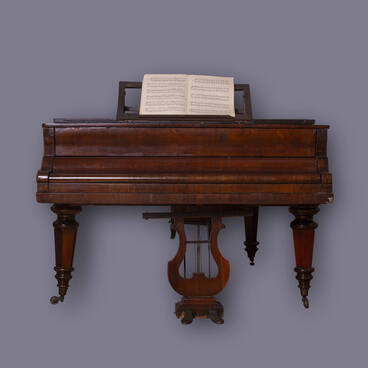In the early 1920s, textile factories began to produce a new type of shawls, which were called propaganda scarves. They became a visual means of propaganda, taking a special place in the history of artistic textiles. Portraits of revolutionary figures, elements of state symbols, abbreviations, slogans and memorable dates, as well as the themes of collectivization of agriculture and industrialization of the economy were directly reflected in the artistic design of shawls of those years.
Gradually, new artistic techniques closely related to the art of the avant-garde began to be introduced into industrial production. Thus, the scarf became a vivid symbol of the era, a powerful weapon in the struggle for the ideals of the revolution. Today, propaganda scarves serve as an important material monument of the era and testify to the traditions and innovations that existed in textile design in the 1920s and 1930s.
The propaganda scarf with a portrait of Lenin was produced at the “Fifth October” factory of the State Vladimiro-Alexandrovsky Trust of Cotton Factories of the Supreme Soviet of the USSR in 1924, after Lenin’s death. The sketch of the shawl was made by the artist N. S. Demkov. In October of the same year a trial batch was produced, and in November mass production of such scarves was launched. It was given as a memorable gift to all workers of the enterprise, as well as honorary guests of festive events of the factory, dedicated to the seventh anniversary of the October Revolution.
In 1925, a limited run of fifteen hundred propaganda scarves was produced for the First All-Russian Congress of Teachers. In December of that year delegates from all over the country gathered in Moscow. N. K. Krupskaya gave each of them a small collection of books and this textile product.
The traditional composition of the scarf consists of five sections connected to the general background. The central field, decorated with a chest-length portrait of Lenin in a round medallion, is surrounded by a decorative frieze with the image of the walking future generation of the Soviet people and explanatory inscriptions about the monetary reform, the cultural revolution and other signs of the time. The dark brown background of the piece is covered with an exquisite lace drawing including portraits of K. Marx, F. Engels, M. I. Kalinin, and L. D. Trotsky.
Gradually, new artistic techniques closely related to the art of the avant-garde began to be introduced into industrial production. Thus, the scarf became a vivid symbol of the era, a powerful weapon in the struggle for the ideals of the revolution. Today, propaganda scarves serve as an important material monument of the era and testify to the traditions and innovations that existed in textile design in the 1920s and 1930s.
The propaganda scarf with a portrait of Lenin was produced at the “Fifth October” factory of the State Vladimiro-Alexandrovsky Trust of Cotton Factories of the Supreme Soviet of the USSR in 1924, after Lenin’s death. The sketch of the shawl was made by the artist N. S. Demkov. In October of the same year a trial batch was produced, and in November mass production of such scarves was launched. It was given as a memorable gift to all workers of the enterprise, as well as honorary guests of festive events of the factory, dedicated to the seventh anniversary of the October Revolution.
In 1925, a limited run of fifteen hundred propaganda scarves was produced for the First All-Russian Congress of Teachers. In December of that year delegates from all over the country gathered in Moscow. N. K. Krupskaya gave each of them a small collection of books and this textile product.
The traditional composition of the scarf consists of five sections connected to the general background. The central field, decorated with a chest-length portrait of Lenin in a round medallion, is surrounded by a decorative frieze with the image of the walking future generation of the Soviet people and explanatory inscriptions about the monetary reform, the cultural revolution and other signs of the time. The dark brown background of the piece is covered with an exquisite lace drawing including portraits of K. Marx, F. Engels, M. I. Kalinin, and L. D. Trotsky.



